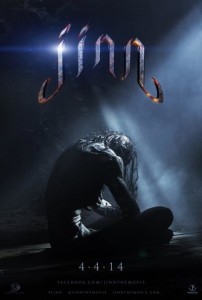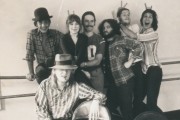 A man walks into a cavern where a skeletal figure sits in the center, head bowed. The man approaches it chanting quietly, scared out of his mind. The place is India. The time is 1901. The confrontation these two have will reverberate though the generations. Writer and Director Ajmal Zaheer Ahmad’s Jinn focuses on a creature that is well known in popular culture, but not from the biblical roots that the film uses as a basis for the monster. This isn’t a genie capable of granting wishes as much as it is a demonic creature from before the time of man. Focusing on the modern Shawn (Dominic Rains) ancestor of a jinn hunter, the film deals with him being haunted by the beast. When his wife Jasmine (Serinada Swan) is kidnapped, Shawn must join a priest (William Atherton) and mysterious man (Ray Park) to get her back.
A man walks into a cavern where a skeletal figure sits in the center, head bowed. The man approaches it chanting quietly, scared out of his mind. The place is India. The time is 1901. The confrontation these two have will reverberate though the generations. Writer and Director Ajmal Zaheer Ahmad’s Jinn focuses on a creature that is well known in popular culture, but not from the biblical roots that the film uses as a basis for the monster. This isn’t a genie capable of granting wishes as much as it is a demonic creature from before the time of man. Focusing on the modern Shawn (Dominic Rains) ancestor of a jinn hunter, the film deals with him being haunted by the beast. When his wife Jasmine (Serinada Swan) is kidnapped, Shawn must join a priest (William Atherton) and mysterious man (Ray Park) to get her back.
The best aspect of the film is absolutely its aesthetics. The opening credits are incredibly creative, describing the mythology of the film in a storybook form, complete with colored sketches. Starting with different religious iconography and evolving into drawings of humans, angels, and Jinn, the opening makes the Jinn less like a supernatural nuisance and more like a legendary force of nature. The visual delights only increase from there, as the first shot is a beautiful Indian village, lush with plant life and animals. A beach surrounding it, the atmosphere feels more suited to a fantasy land than India in 1901. This demonstrates the beautiful cinematography, done by Robert Mehnert. There isn’t a single shot that is bland or ordinary; each shot brings out the best the frame has to offer. The opening scenes are bright and colorful, and when a Jinn is being fought in a cavern, the scene isn’t as traditionally dark as one would expect. Instead, the shot is lit that the blue of the cavern stands out the most, creating a naturally “cool” feeling. Even when the locations change from more exotic to more mundane and modern, each setting’s natural strength is brought out. The best example of this would be the asylum the characters visit to talk to a mysterious man who can teach Shawn about the Jinn. His cell is white—a traditional look for a mental hospital. But it’s not drab. There’s a brightness to the white walls, one that not only visually looks appealing, but also brings out the optimism hidden in the room’s occupant as well. The film also has some of the best locations seen in recent memory. The previously mentioned Indian landscape and caverns stand out, but the best example is when Shawn trains in a secluded place. Rather than a traditional warehouse or basement, he goes to an auto factory, and the rusty cars and metal that surround him add a touch of uniqueness to the film. The visual effects are also phenomenal, be it jinn rising up, turning into smoke, or becoming beings of molten fire. Like the cinematography, each effect is a thrill to look at—an art in itself, particularly the shots of the jinn in a charcoal-like human form.
The acting is also solid, with Swan standing out. Her role is the kind of role that can easily be overacted and she manages to find a balance that makes her seem charming and natural in her role as “bumbling wife.” When she’s upset with her husband, it comes off as normal, which is difficult to do considering that the character’s actions are oftentimes illogical. Atherton also shines as the priest as well, with some strong one-liners and a terseness to him that isn’t always apparent in a man of God. The direction is also handled quite well, managing the line between horror and action fairly seamlessly. Jump scares are the main horror technique utilized, and while they may be overplayed, they can work strongly—and work well here they did, with a handful of heat-pounding moments. The action, choreographed by Ray Park, is the equivalent of watching a ballet, with exquisite moment and timing.
For all the good of the film, it has one major flaw: the script itself. The Jinn are a concept that have a lot of narrative potential, but the story doesn’t do anything with it. The Jinn might as well just be demons or similar supernatural creatures, which is a shame. Furthermore, logic holes often threaten to stop the flow of the narrative. The jinn threatens Shawn’s ancestor seemingly for no reason, and Jasmine’s concern about children seems out-of-place for a couple married for seemingly some time. Furthermore, the character in the asylum is there because he failed the Jinn’s test years ago…SPOILER yet when Shawn is in danger, he’s magically able to escape, fight the jinn in his mind, and be all better END SPOILER. These plot points strain credibility, but that could be fine if the film is daring narratively otherwise. Unfortunately, not only is it not daring, it’s far too safe. The Jinn are after Shawn because of a prophecy, and killed his father because of it, trying to start a huge war between jinn and humanity. It’s the same beats of adventure and fantasy films seen a hundred times before, and nothing to distinguish it from the pack. The dialogue also doesn’t help—it isn’t bad, just mediocre, but it’s bothersome to see great actors trying to work with lines that clearly aren’t natural. Unfortunately, the film’s script couldn’t borrow some of the brilliance that its visuals had.
Review Overview

















Recent Comments